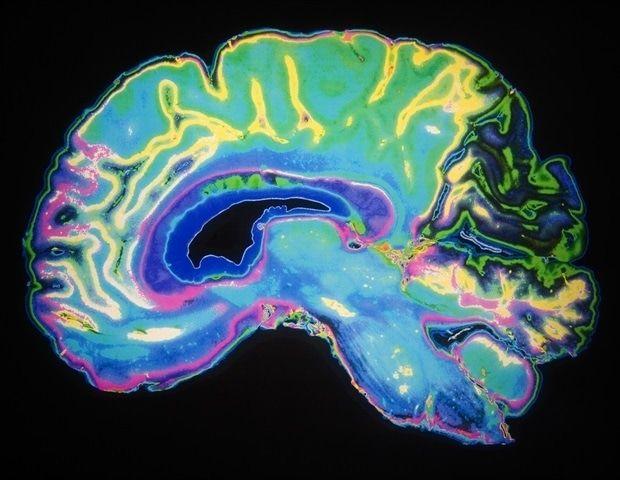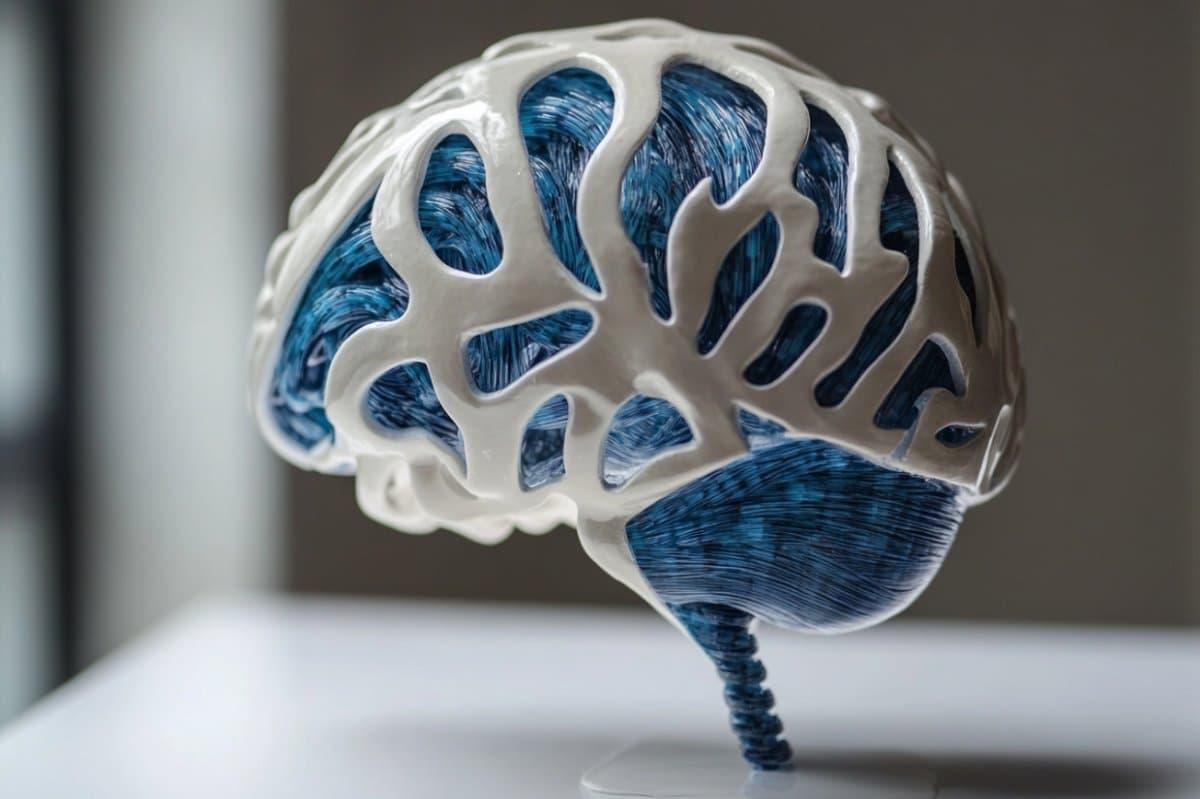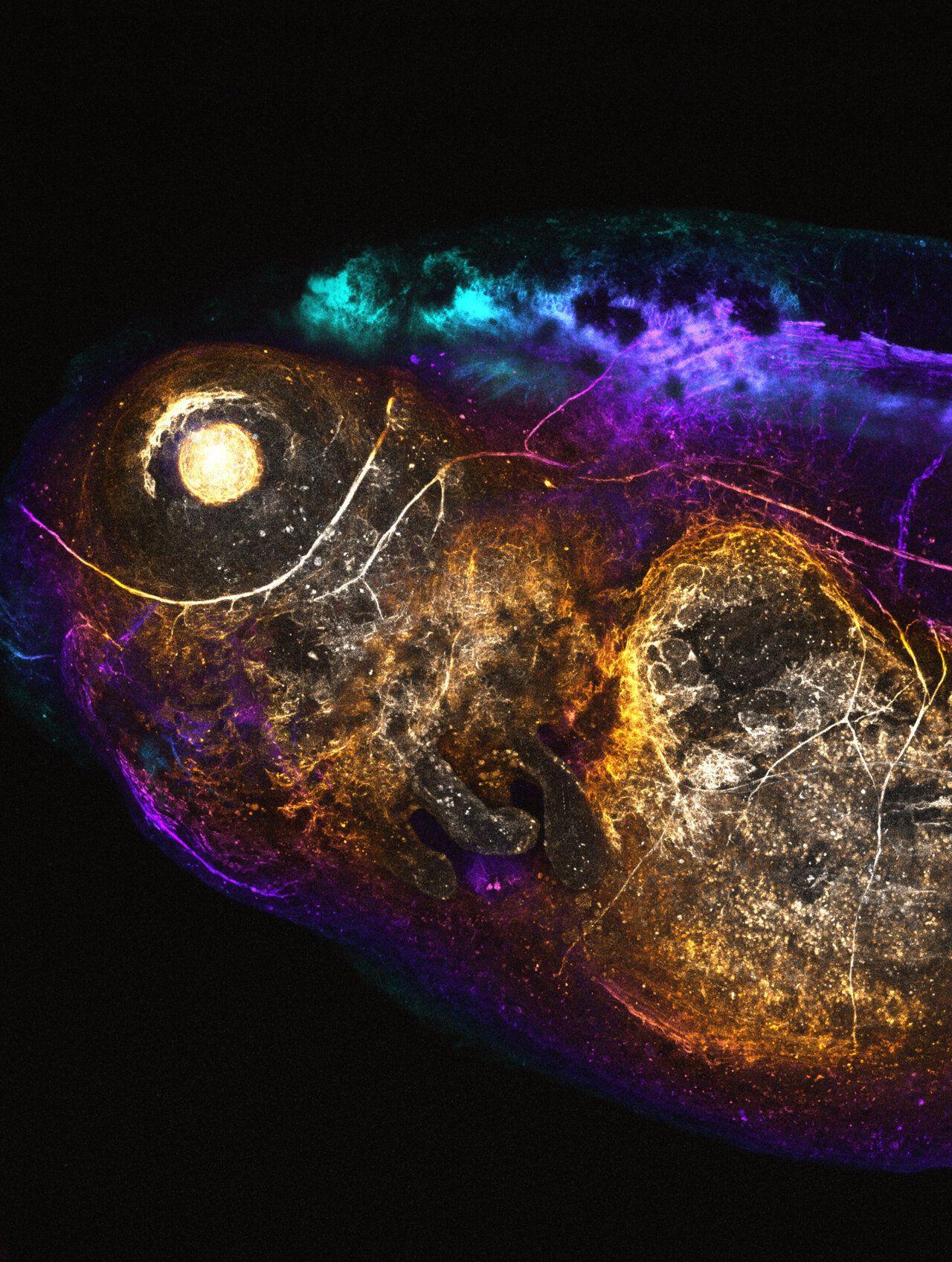AI-Powered Gene Delivery Systems Revolutionize Brain and Spinal Cord Research
3 Sources
3 Sources
[1]
Scientists design gene delivery systems for cells in the brain and spinal cord
Research teams funded by the National Institutes of Health (NIH) have created a versatile set of gene delivery systems that can reach different neural cell types in the human brain and spinal cord with exceptional accuracy. These delivery systems are a significant step toward future precise gene therapy to the brain that could safely control errant brain activity with high precision. In contrast, current therapies for brain disorders mostly treat only symptoms. The new delivery systems carry genetic material into the brain and spinal cord for targeted use by specific cell types. This platform has the potential to transform how scientists can study neural circuits. It provides researchers with gene delivery systems for various species used in research, without the need for genetically modified, or transgenic, animals. Examples include illuminating fine structures of brain cells with fluorescent proteins and activating or silencing circuits that control behavior and cognition. "Imagine this new platform as a delivery truck dropping off specialized genetic packages in specific cell neighborhoods in the brain and spinal cord," said John Ngai, Director of the NIH's Brain Research Through Advancing Innovative Neurotechnologies® Initiative, orThe BRAIN Initiative®. "With these delivery systems, we can now access and manipulate specific cells in the brain and spinal cord -- access that was not possible before at this scale." The new delivery tools, which use a small, stripped-down adeno-associated virus (AAV) to deliver DNA to target cells, can be broadly applied across many species and experimental systems, including small tissue samples removed during human brain surgeries. The delivery systems have been tested, or validated, in intact living systems, which is an important step for introducing new tools for widespread use. The newly published toolkit includes: Overall, this collection of research tools will significantly accelerate understanding of the human brain. Importantly, the toolkit enables access to specific brain cell types in the prefrontal cortex, an area that's critical for decision-making and uniquely human traits. With other tools in the collection, scientists can better study individual cells and communication pathways known to be affected in several neurological diseases. These include seizure disorders, ALS, Parkinson's disease, Alzheimer's disease, and Huntington's disease -- as well as various neuropsychiatric conditions. AAV-based treatments are already approved for some conditions, such as spinal muscular atrophy for which a 2016 approval of a gene therapy known as Zolgensma transformed the lives of infants and young children who once faced severe disability or early death. The new collection of gene delivery resources lays the groundwork for more precise treatments that target only affected cells in the brain, spinal cord, or brain blood vessels. The toolkit is available at distribution centers including Addgene, a global supplier of genetic research tools. This collection of publications offers researchers standard operating procedures and user guides for these tools. The work is supported by the NIH's Brain Research Through Advancing Innovative Neurotechnologies® Initiative, orThe BRAIN Initiative®. Funding issued less than four years ago launched a large-scale, team-run project to design new molecular tools that can be useful to many research laboratories. The Armamentarium for Precision Brain Cell Access aims to develop precise and reproducible access to cells and circuits in experimental research models of the brain and spinal cord. The large-scale project brings together experts in the field of molecular biology, neuroscience, and artificial intelligence (AI). The eight papers appear in the May 21 issue of the journals Neuron, Cell, Cell Reports, Cell Genomics, and Cell Reports Methods. Grants: UF1MH130701, UH3MH120096, U24MH133236, UF1MH128339, UM1MH130981, R01MH123620, U19MH114830, P510D010425, U420D011123, S10MH126994, UH3MH120094, UF1MH130881, F30DA053020, R01FD007478, U01AG076791, R35GM127102, RF1MH114126, UH3MH120095, RF1MH121274, R01MH113005, UH3MH120095
[2]
AI-Guided Gene Vectors Precisely Target Brain and Spinal Cells - Neuroscience News
Summary: Scientists have engineered dozens of adeno-associated virus (AAV) systems that ferry genes to specific neuron and glial subtypes in the brain and spinal cord with unprecedented accuracy. Powered by AI-selected DNA "light switches," the vectors can switch on therapeutic or research genes only in targeted cells, eliminating the need for transgenic animals and enabling fine-grained circuit mapping, activation, or silencing. Validated across multiple species and human surgical tissue, the toolkit reaches elusive cells implicated in disorders like ALS, epilepsy, and Parkinson's disease. By focusing treatment on malfunctioning cells alone, these tools lay a foundation for next-generation brain gene therapies that address root causes rather than symptoms. Research teams funded by the National Institutes of Health (NIH) have created a versatile set of gene delivery systems that can reach different neural cell types in the human brain and spinal cord with exceptional accuracy. These delivery systems are a significant step toward future precise gene therapy to the brain that could safely control errant brain activity with high precision. In contrast, current therapies for brain disorders mostly treat only symptoms. The new delivery systems carry genetic material into the brain and spinal cord for targeted use by specific cell types. This platform has the potential to transform how scientists can study neural circuits. It provides researchers with gene delivery systems for various species used in research, without the need for genetically modified, or transgenic, animals. Examples include illuminating fine structures of brain cells with fluorescent proteins and activating or silencing circuits that control behavior and cognition. "Imagine this new platform as a delivery truck dropping off specialized genetic packages in specific cell neighborhoods in the brain and spinal cord," said John Ngai, Director of the NIH's Brain Research Through Advancing Innovative Neurotechnologies® Initiative, or The BRAIN Initiative®. "With these delivery systems, we can now access and manipulate specific cells in the brain and spinal cord - access that was not possible before at this scale." The new delivery tools, which use a small, stripped-down adeno-associated virus (AAV) to deliver DNA to target cells, can be broadly applied across many species and experimental systems, including small tissue samples removed during human brain surgeries. The delivery systems have been tested, or validated, in intact living systems, which is an important step for introducing new tools for widespread use. The newly published toolkit includes: Overall, this collection of research tools will significantly accelerate understanding of the human brain. Importantly, the toolkit enables access to specific brain cell types in the prefrontal cortex, an area that's critical for decision-making and uniquely human traits. With other tools in the collection, scientists can better study individual cells and communication pathways known to be affected in several neurological diseases. These include seizure disorders, ALS, Parkinson's disease, Alzheimer's disease, and Huntington's disease - as well as various neuropsychiatric conditions. AAV-based treatments are already approved for some conditions, such as spinal muscular atrophy for which a 2016 approval of a gene therapy known as Zolgensma transformed the lives of infants and young children who once faced severe disability or early death. The new collection of gene delivery resources lays the groundwork for more precise treatments that target only affected cells in the brain, spinal cord, or brain blood vessels. The toolkit is available at distribution centers including Addgene, a global supplier of genetic research tools. This collection of publications offers researchers standard operating procedures and user guides for these tools. The work is supported by the NIH's Brain Research Through Advancing Innovative Neurotechnologies® Initiative, or The BRAIN Initiative®. Funding issued less than four years ago launched a large-scale, team-run project to design new molecular tools that can be useful to many research laboratories. The Armamentarium for Precision Brain Cell Access aims to develop precise and reproducible access to cells and circuits in experimental research models of the brain and spinal cord. The large-scale project brings together experts in the field of molecular biology, neuroscience, and artificial intelligence (AI). Grants: UF1MH130701, UH3MH120096, U24MH133236, UF1MH128339, UM1MH130981, R01MH123620, U19MH114830, P510D010425, U420D011123, S10MH126994, UH3MH120094, UF1MH130881, F30DA053020, R01FD007478, U01AG076791, R35GM127102, RF1MH114126, UH3MH120095, RF1MH121274, R01MH113005, UH3MH120095. An enhancer-AAV toolbox to target and manipulate distinct interneuron subtypes In recent years, we and others have identified a number of enhancers that, when incorporated into rAAV vectors, can restrict the transgene expression to particular neuronal populations. Yet, viral tools to access and manipulate specific neuronal subtypes are still limited. Here, we performed systematic analysis of single-cell genomic data to identify enhancer candidates for each of the telencephalic interneuron subtypes. We established a set of enhancer-AAV tools that are highly specific for distinct cortical interneuron populations and striatal cholinergic interneurons. These enhancers, when used in the context of different effectors, can target (fluorescent proteins), observe activity (GCaMP), and manipulate (opto-genetics) specific neuronal subtypes. We also validated our enhancer-AAV tools across species. Thus, we provide the field with a powerful set of tools to study neural circuits and functions and to develop precise and targeted therapy.
[3]
New gene delivery systems can reach cells in the brain and spinal cord with exceptional accuracy
National Institutes of Health (NIH)May 21 2025 Research teams funded by the National Institutes of Health (NIH) have created a versatile set of gene delivery systems that can reach different neural cell types in the human brain and spinal cord with exceptional accuracy. These delivery systems are a significant step toward future precise gene therapy to the brain that could safely control errant brain activity with high precision. In contrast, current therapies for brain disorders mostly treat only symptoms. The new delivery systems carry genetic material into the brain and spinal cord for targeted use by specific cell types. This platform has the potential to transform how scientists can study neural circuits. It provides researchers with gene delivery systems for various species used in research, without the need for genetically modified, or transgenic, animals. Examples include illuminating fine structures of brain cells with fluorescent proteins and activating or silencing circuits that control behavior and cognition. Imagine this new platform as a delivery truck dropping off specialized genetic packages in specific cell neighborhoods in the brain and spinal cord. With these delivery systems, we can now access and manipulate specific cells in the brain and spinal cord - access that was not possible before at this scale." John Ngai, Director of the NIH's Brain Research Through Advancing Innovative Neurotechnologies® Initiative, or The BRAIN Initiative® The new delivery tools, which use a small, stripped-down adeno-associated virus (AAV) to deliver DNA to target cells, can be broadly applied across many species and experimental systems, including small tissue samples removed during human brain surgeries. The delivery systems have been tested, or validated, in intact living systems, which is an important step for introducing new tools for widespread use. The newly published toolkit includes: Dozens of delivery systems that selectively target key brain cell types, including excitatory neurons, inhibitory interneurons, striatal and cortical subtypes, brain blood vessel cells, and hard-to-reach neurons in the spinal cord that control body movement and are damaged in several neurological diseases, such as amyotrophic lateral sclerosis (ALS) and spinal muscular atrophy Computer programs powered by artificial intelligence (AI) that can identify genetic "light switches," known as enhancers, that turn genes on in specific brain cell types, using data from many different species - cutting considerable time and effort for scientists looking for these genetic switches. Overall, this collection of research tools will significantly accelerate understanding of the human brain. Importantly, the toolkit enables access to specific brain cell types in the prefrontal cortex, an area that's critical for decision-making and uniquely human traits. With other tools in the collection, scientists can better study individual cells and communication pathways known to be affected in several neurological diseases. These include seizure disorders, ALS, Parkinson's disease, Alzheimer's disease, and Huntington's disease - as well as various neuropsychiatric conditions. AAV-based treatments are already approved for some conditions, such as spinal muscular atrophy for which a 2016 approval of a gene therapy known as Zolgensma transformed the lives of infants and young children who once faced severe disability or early death. The new collection of gene delivery resources lays the groundwork for more precise treatments that target only affected cells in the brain, spinal cord, or brain blood vessels. The toolkit is available at distribution centers including Addgene, a global supplier of genetic research tools. This collection of publications offers researchers standard operating procedures and user guides for these tools. The work is supported by the NIH's Brain Research Through Advancing Innovative Neurotechnologies® Initiative, or The BRAIN Initiative®. Funding issued less than four years ago launched a large-scale, team-run project to design new molecular tools that can be useful to many research laboratories. The Armamentarium for Precision Brain Cell Access aims to develop precise and reproducible access to cells and circuits in experimental research models of the brain and spinal cord. The large-scale project brings together experts in the field of molecular biology, neuroscience, and artificial intelligence (AI). The eight papers appear in the May 21 issue of the journals Neuron, Cell, Cell Reports, Cell Genomics, and Cell Reports Methods. National Institutes of Health (NIH)
Share
Share
Copy Link
NIH-funded research teams have developed a versatile set of gene delivery systems that can target specific neural cell types in the brain and spinal cord with unprecedented accuracy, paving the way for precise gene therapies and advanced neuroscience research.
Breakthrough in Gene Delivery Systems for Neural Cells
Research teams funded by the National Institutes of Health (NIH) have achieved a significant breakthrough in gene delivery systems, creating a versatile toolkit that can target specific neural cell types in the brain and spinal cord with exceptional accuracy
1
. This development marks a crucial step towards precise gene therapies for brain disorders, potentially offering treatments that address root causes rather than just symptoms.
Source: News-Medical
AI-Powered Genetic "Light Switches"
The new delivery tools utilize a small, stripped-down adeno-associated virus (AAV) to deliver DNA to target cells. What sets this toolkit apart is the incorporation of AI-selected DNA "light switches" or enhancers, which can activate therapeutic or research genes only in targeted cells
2
. This innovation eliminates the need for genetically modified animals in research and enables fine-grained circuit mapping, activation, or silencing.Versatility and Cross-Species Applicability
One of the most promising aspects of this new platform is its broad applicability across various species and experimental systems. The delivery systems have been validated in intact living systems, including small tissue samples from human brain surgeries
3
. This cross-species functionality significantly accelerates the potential for translating research findings into clinical applications.Targeting Elusive Cell Types
The toolkit provides unprecedented access to specific brain cell types, including those in the prefrontal cortex - an area critical for decision-making and uniquely human traits. It also enables better study of individual cells and communication pathways implicated in various neurological diseases such as ALS, Parkinson's disease, Alzheimer's disease, and Huntington's disease
1
.
Source: Neuroscience News
Implications for Future Therapies
While AAV-based treatments are already approved for some conditions, such as the gene therapy Zolgensma for spinal muscular atrophy, this new collection of gene delivery resources lays the groundwork for even more precise treatments. These future therapies could target only affected cells in the brain, spinal cord, or brain blood vessels, potentially revolutionizing treatment approaches for a wide range of neurological disorders
2
.Related Stories
Collaborative Effort and Availability
This breakthrough is the result of a large-scale, team-run project known as the Armamentarium for Precision Brain Cell Access, which brings together experts in molecular biology, neuroscience, and artificial intelligence. The toolkit is now available at distribution centers, including Addgene, a global supplier of genetic research tools
3
.Future Prospects
As John Ngai, Director of the NIH's BRAIN Initiative, puts it, "With these delivery systems, we can now access and manipulate specific cells in the brain and spinal cord - access that was not possible before at this scale"
1
. This advancement opens up new possibilities for understanding and treating neurological disorders, potentially transforming the landscape of neuroscience research and therapeutic development in the coming years.References
Summarized by
Navi
[2]
Related Stories
AI Breakthrough: Designing Synthetic DNA Switches for Precise Gene Control
24 Oct 2024•Science and Research

Yale Researchers Develop AI Tool to Precisely Time Gene Activation in Brain Development
20 Aug 2025•Science and Research

AI-Powered 'Pythia' Tool Revolutionizes Precision in CRISPR Gene Editing
13 Aug 2025•Science and Research

Recent Highlights
1
Google launches Gemini 3 Flash as default AI model, delivering speed with Pro-grade reasoning
Technology

2
OpenAI launches GPT Image 1.5 as AI image generator war with Google intensifies
Technology

3
OpenAI launches ChatGPT app store, opening doors for third-party developers to build AI-powered apps
Technology





